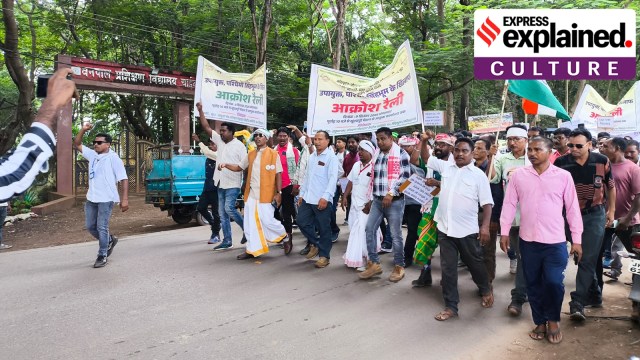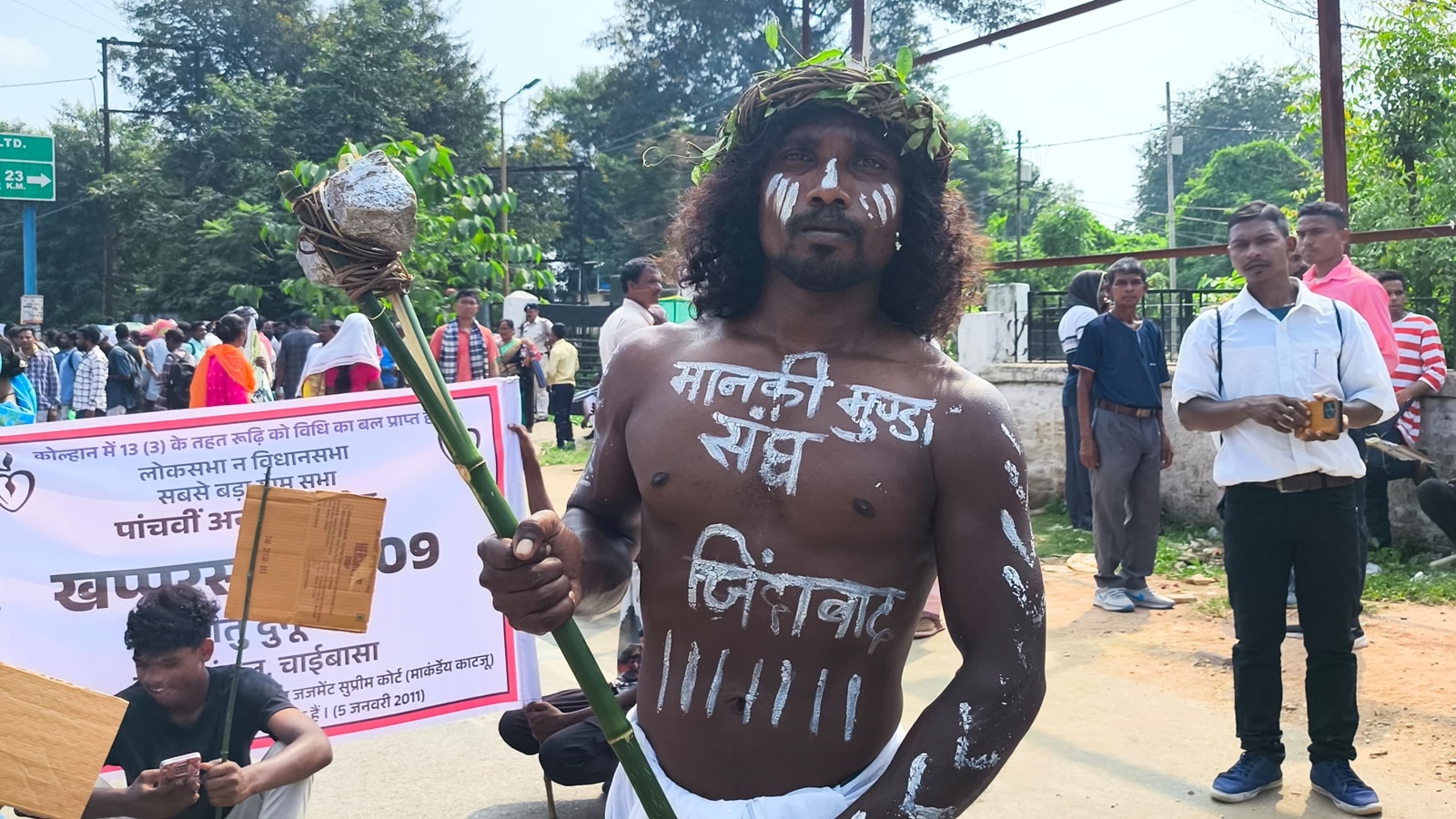On Tuesday (September 9), adivasis from the Ho tribe staged a protest in Jharkhand’s West Singhbhum district against the Deputy Commissioner (DC), accusing him of interfering with their traditional self-governance system by removing village heads, known as Mundas.
The district administration has since clarified that the protest was a result of rumor mongering on social media, and that Mankis and Mundas remain integral to the revenue system. But adivasi concerns persist, with many fearing the loss of their autonomy and a traditional system.

This conflict threatens a century-old balance between the indigenous governance system, the so-called Manki-Munda system, and the state administration in Ho areas of Jharkhand’s Kolhan region.
The Manki-Munda system
For centuries before the arrival of the British, the Ho tribe of Jharkhand’s Kolhan region lived under their traditional, decentralised system of governance which revolved around the social and political responsibilities of various stakeholders.
The Munda, or the head of the village, was responsible for resolving socio-political disputes at the village level. Each village had one Munda, appointed hereditarily. The Manki headed the pir, which generally consists of 8 to 15 villages. If cases were not resolved by the Munda, they moved upwards to the Manki.
The Manki and Munda had no responsibilities for revenue or land-related issues. The system was purely an internal, self-governing mechanism, with no sovereign authority outside or the concept of paying taxes.
Then came the East India Company, and with it, taxes.
Story continues below this ad
 Adivasis organised a march in Kolhan last week. (Special arrangement)
Adivasis organised a march in Kolhan last week. (Special arrangement)
Arrival of the British
After the Battle of Plassey in 1757, the Company quickly expanded its territory and influence. In the aftermath of the Battle of Buxar (1764), the Company signed the Treaty of Allahabad with the Mughal emperor Shah Alam II in 1765, which granted it diwani rights (right to collect taxes) over the province of Bengal (including present day Odisha, Bihar and Jharkhand).
In 1793, the Company administration inntroduced the Permanent Settlement Act, which allotted land deeds to zamindar and set land revenue demands on them (which they had to pay to the Company). These demands were set at an amount fixed forever but higher than most zamindars’ capacity to pay.
As a result, there was immense pressure on zamindars to be as extractive as possible. In Kolhan, they began actively seizing Ho lands to bring them under direct control. This system would eventually trigger a number of early-19th century adivasi revolts, such as the Ho revolt (1821-22) and the Kol revolt (1831-32).
Story continues below this ad
After repeated failures to subdue the Ho people through brute force, the British decided to arrive at a strategic compromise by recognising and co-opting the Manki-Munda system.
Wilkinson’s Rules & impact
The British appointed Captain Thomas Wilkinson as their Political Agent in the Kolhan Government Estate (KGE), an administrative unit created in 1837 to control the Ho-dominated region.
Having already spent time in the region, Wilkinson understood the local dynamics well and realised that the best way to rule KGE was to work with not against their traditional leaders and governance system.
In 1833, he drafted a set of 31 rules, (henceforth, ‘Wilkinson’s Rules’) meant to be the “guiding principles” for the Ho community’s leaders. This was the first time that the traditional system of the Ho community — or for that matter any adivasi community — had been formally codified.
Story continues below this ad
 Adivasis organised a march in Kolhan last week. (Special arrangement)
Adivasis organised a march in Kolhan last week. (Special arrangement)
By acknowledging and giving power to the Mundas and Mankis, the British cleverly turned community leaders into their own agents. And while it ostensibly was meant to preserve tribal autonomy and keep dikkus (non-tribals, outsiders) out, the Rules enabled the integration of Kolhan with the rest of British India.
Perhaps the most significant outcome of this was the influx of dikkus, Manish Surin, a researcher from the Ho community studying in the University of Sussex, told The Indian Express. Between 1867 and 1897, the number of outsiders went up from merely 1,579 to 15,755. “Almost nine times their population increased in 30 years. Though there are various reasons, this was partly facilitated by the introduction of the railway, which brought in more non-tribal people and led to a demographic shift,” he said.
Another change, Surin noted, was the introduction of the concept of private property and land ownership. “The community, which once lived peacefully, was now designated as raiyats (tenants) of the state. This led to the issuance of pattas, fostering a new sense of individual property and ownership, which was absent before,” he said.
System continues
The KGE was dissolved after 1947, but Wilkinson’s Rules are still applicable. While general civil procedure laws were enacted in India after Independence, Kolhan was largely exempted.
Story continues below this ad
Not that these rules were not challenged in the courts. But for many years, courts accepted Wilkinson’s Rules as valid in various cases. It was only in 2000, in Mora Ho vs State of Bihar in the Patna High Court, that the judges held that Wilkinson’s Rules were simply old customs, not formal law. That said, the Bench allowed the rules to continue since no alternative existed.
One judge would later order the government to update them, but neither Bihar nor the new Jharkhand state made progress in this regard.
In Feb 2021, the Jharkhand government recognised the traditional judicial system known as the Nyaya Panch to work on revenue related activities such as tax collection and reporting of land purchase and sale, maintaining law & order and settlement of disputes.
The current conflict
According to Chandan Kumar, the DC of West Singhbhum district, the current conflict is the product of a series of complaints made by SCs and OBCs residing in Ho-dominated villages to the village administration.
Story continues below this ad
The first complaint was made to the DC in June. It was regarding Mundas denying the Gope community, traditional livestock rearers, engaging in livelihoods other than their traditional roles. In another incident, villagers complained about the Munda’s prolonged absence from the village, which prevented them from receiving official documents and caused difficulties.
The district administration took cognizance of these complaints and issued a nine-point directive to bring transparency to the Manki-Munda system, reminding the Mundas of their responsibilities mentioned in the “record of rights” (Hukuknama) framed in 1837 by Wilkinson.
“This was misinterpreted by the villagers and rumours spread that the DC is taking action against the Mundas or the Mankis for not performing their roles properly… No district administration has and will ever interfere with customary laws,” Kumar said.
Larger issues
According to government data, there are 1,850 posts for Mankis and Mundas in the West Singhbhum district, of which 200 are vacant. The administration has taken steps to fill the vacant posts with the help of Gram Sabhas. “In the last two months, we have filled 50 vacant positions,” Kumar said.
Story continues below this ad
Chandan Honhaga, the general secretary of the Manki Munda Sangh, stated that some roles were assigned to non-tribal raiyats. “They should not have bypassed the village system… they refused to dispose of the case at the village level,” he said.
That said, there is a section of the Ho community, especially the youth, who want reforms to the Manki-Munda system. Ending/ Removing the hereditary role of the Munda and giving a fair chance to the educated , competent tenants.
There are posts of assistant Munda and Manki to help the village headmen distribute the workload.
To become Munda or Manki, a son inherits the role from his father. This has created problems in recent times, as many of these traditional leaders are not formally educated, making it difficult for them to navigate the modern, document-based administrative system. This is what drives unsatisfied villagers to the district administration.
Story continues below this ad
Shankar Sidhu, treasurer of the Adivasi Ho Yuva Mahasabha’s Jharkhand unit, said the role of the DC in the traditional Manki-Munda system today is “limited but crucial.”
He explained that while the system is based on the Hukuknama, “almost 80 percent of Mankis and Mundas cannot fully understand its provisions.” To address this, he said, the DC simplified the interpretations in nine points, particularly in matters of dismissal or land disputes.
“The DC mainly intervenes when disputes cannot be resolved locally,” Shankar said. “If a Munda dies and there is no successor, the administration restores vacant posts through Gram Sabhas or block-level officials.”
Shankar said that the traditional system should be preserved and, but needs reform in the context of a 21st century democracy.



 Adivasis organised a march in Kolhan last week. (Special arrangement)
Adivasis organised a march in Kolhan last week. (Special arrangement) Adivasis organised a march in Kolhan last week. (Special arrangement)
Adivasis organised a march in Kolhan last week. (Special arrangement)




































